Lots of pictures: sorry if you're on dial-up.
Here's the shiny porn shot, so we can get it over with:
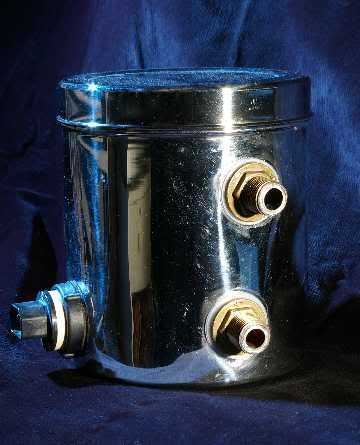
I started with a £6.50 stainless storage jar (about 3.4 litres to the top) from a kitchen shop in Southall (high quality Indian stainless products here):
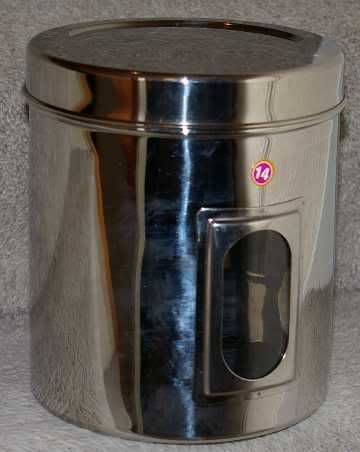
The window leaked, so I ran some food-grade silicone sealant round the inside.
I drilled a 40mm hole for the kettle element near the bottom, with a Bosch cobalt holesaw as recommended on JBK, and put the element in so I could see where to put the hole for the bottom tank connector. The lowest bit of copper tube had to definitely miss the element!
The jar is only 155mm diameter, so I had some trouble getting the kettle element to seal on the curved surface. I tried hammering it flat around the hole, but lacking an anvil with a long beak I had to resort to bodgery as usual. Using a club hammer held in the vice:
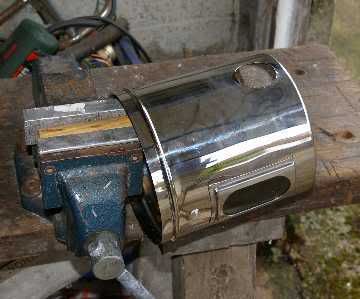
the chisel end of a big crowbar:
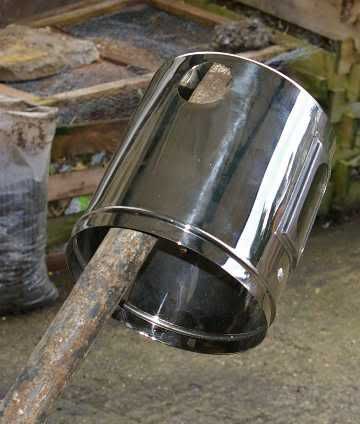
a heavy right-angle bracket from an office partition thing:
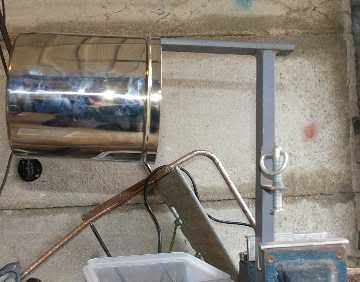
and finally a piece of 2x4 and a rivet set as a flat-ended punch:
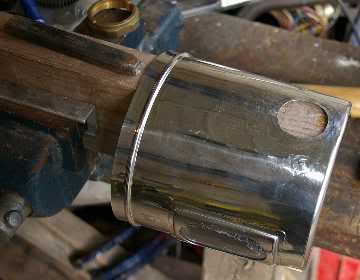
That's about as flat as it was ever going to get without some kind of concave punch-and-die system. Squashing it between two flat things, like a pair of lathe changewheels, had no effect, as the thin stainless (about 0.8mm) is very springy! Eventually I tried two rubber element washers between the element and the jar, and the afore-mentioned silicone sealant, and it worked. Look no leaks:
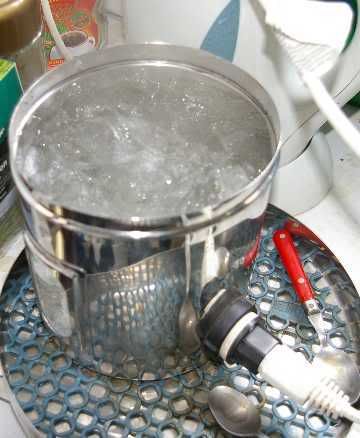
Unlike some of my heroes mentioned above, I decided to put the the tank connectors facing outwards (i.e. threaded part outside the heat exchanger) so I could screw on the Camlock couplings (if you take the compression nut and olive away you have a 1/2" BSP thread). The 15mm compression tank connectors have a step inside, where the pipe stops in normal use:
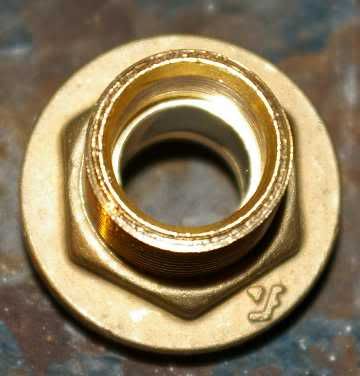
so I drilled this out with a 15mm blacksmith's drill, doing a bit from each side:
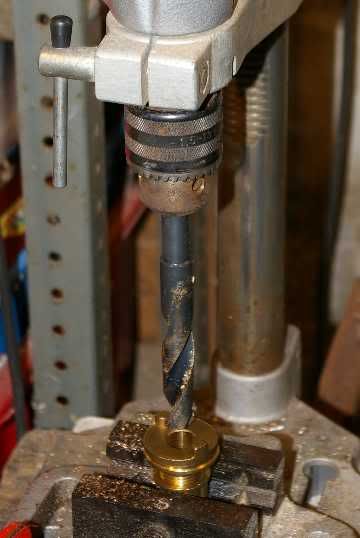
The tank connector was screwed into another 1/2" BSP thing I had, so the vice jaws couldn't damage the thread:
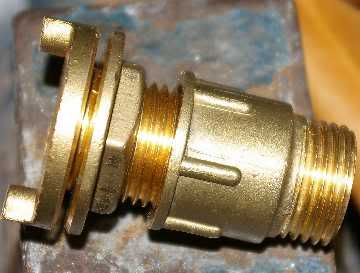
I had some squirty cutting compound for drilling.
Next I soldered one of the connectors onto a stub of 15mm copper pipe (lead-free solder):
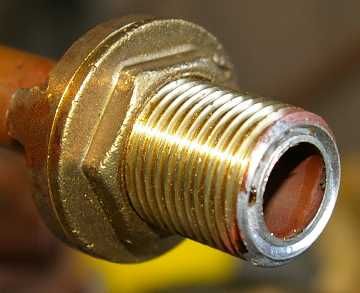
and you can see my dodgy soldering at the back:
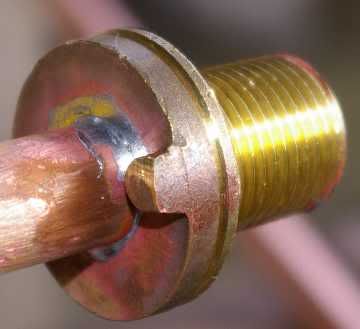
If like me you wind up with solder on the threads you'll have to hacksaw/file it off carefully otherwise nothing will want to screw on.
I own a cheapo pipe bender, from when I did the bathroom, so I found by trial and error that you can make a coil with it. Starting like this:

then you have to persuade the first and subsequent turns to miss the big curved thing (die?) on the pipe bender and not jam up anywhere:
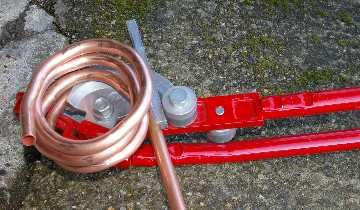
It's not pretty, on my first attempt. I got bored about here:
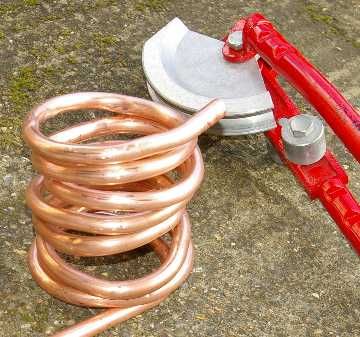
First of all I tried the coil of pipe with a 15mm solder-ring elbow pointing away from the coil, but there was no way I could ever get the tank connector through the hole in the jar, so plan B had the end of the coil soldered to an elbow pointing inwards from the coil to the stub with the tank connector on, and then I tried it in the jar for fit:
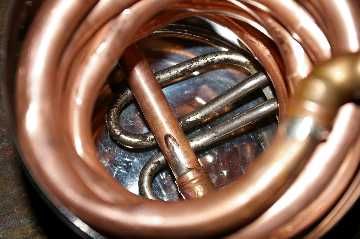
Obviously I had done too many turns!
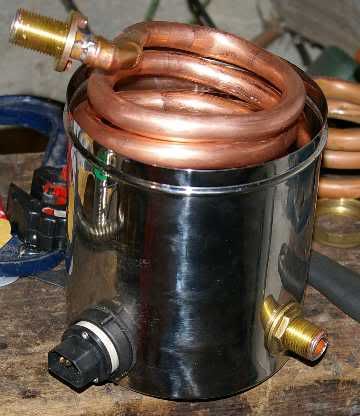
Cut it off, assemble an elbow and another stub of pipe, and find out where the top hole has to go. I did the holes for the tank connectors with a 20mm cobalt holesaw, which is what they had at Screwfix. Unfortunately you need about 21.5mm diameter to clear a 1/2" BSP thread, so I opened-out the holes and deburred them with the Minicraft drill and a little rasp bit. I now have a 22mm holesaw from Axminster Power Tools - they carry all the sizes.
Here is the thing assembled with plastic tank washers and silicone sealant:
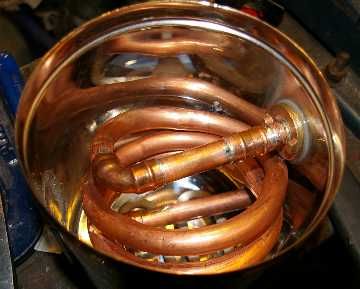

and here it is on a water test using horrible garden hose:

You can see the 1/2" BSP tee (from BES) on the top (the outlet) with the Pt100 probe in its compression fitting, pointing into the cross-ways stub pipe. Instead of doing-up the 1/8" compression fitting with the olive as supplied, I put a bit of self-amalgam tape round the Pt100 probe to form a sort of rubber grommet, in case I wanted to get it out again easily.
In the darkroom with the electric drill pump and some nice hose with go-faster stripes:
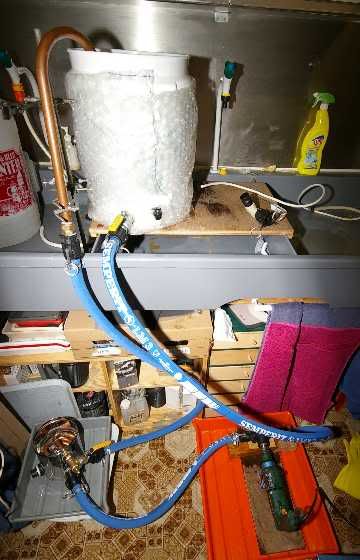
and eventually with the nice hose and the March 809 pump when it turned up from March May:

Finally I got to brew with it last weekend (20th of April), in the garage:

Here it is on the floor with the March pump - you can see the Camlock hose fittings:
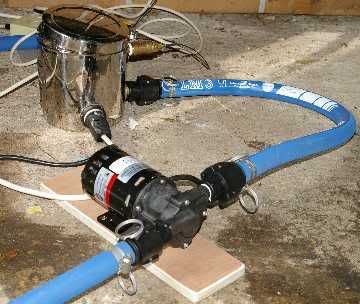
Using the HERMS system with the PID controller was a joy, once I'd sorted-out a few calibration problems. The temperature steps were a piece of p*** and to change up by 10 degrees took about 10 or 15 minutes. After the brew the bottling department asked where was the element covered in black crud, as seen previously when I heated the mash directly in the Electrim boiler, and I had to explain that this was the point - the element in the boiler had pre-heated the mash liquor and then done the main boil, so it only had a bit of light brown fur from the boil, which came off easily with a toothbrush!
If anyone wants a bit of pre-coiled 15mm pipe I have these leftover bits:
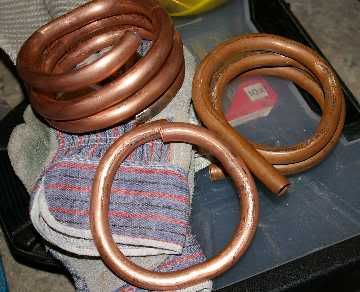
so send me a PM and I'll put one in the post for you.



